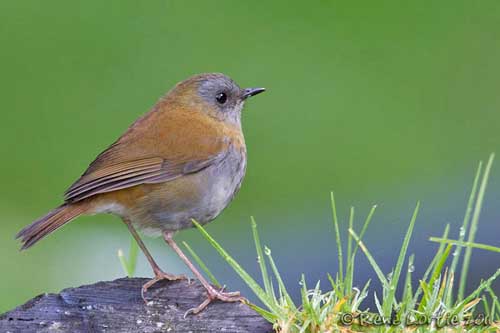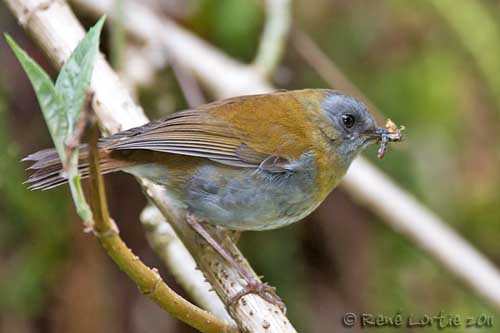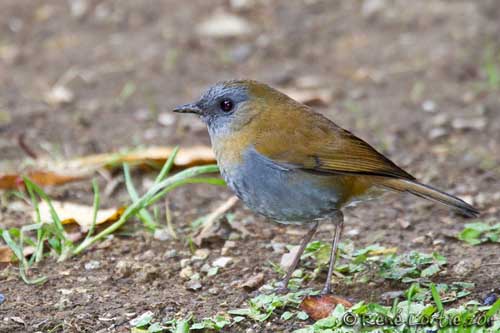
Fr: grive à bec noir
All : Graukehl-Musendrossel
Esp: Zorzal piquinegro
Ital: Tordo usignolo beccofine
Nd: Grijskeeldwerglijster
Sd: Svartnäbbad skogstrast
Photographer:
René Lortie
http://rlortie.ca/
Text by Nicole Bouglouan
Sources:
HANDBOOK OF THE BIRDS OF THE WORLD Vol 10 by Josep del Hoyo-Andrew Elliott-David Christie - Lynx Edicions - ISBN: 8487334725
THRUSHES by Peter Clement and Ren Hathway – HELM - ISBN: 0713639407
BirdLife International (BirdLife International)
Neotropical Birds – Cornell Lab of Ornithology
Wikipedia, the free encyclopaedia
Black-billed Nightingale-Thrush
Catharus gracilirostris
Passeriforme Order – Turdidae Family
BIOMETRICS:
Length: 14, 5 – 16 cm
Weight: 21 g
DESCRIPTION:
The Black-billed Nightingale-Thrush is the smallest of the Central American nightingale-thrushes.
The adult of nominate race has warm olive-brown upperparts. On the wings, alula, inner webs of primary coverts and flight feathers are duller brown, like centres of tail feathers.
On the underparts, chin and throat are pale grey. There is a pale brown breastband. Flanks are grey. Middle belly to vent are whitish.
On the head, face, forehead, forecrown and ear-coverts are grey, whereas nape and neck sides are olive-brown.
The bill is black. The eyes are dark brown. Legs and feet are pale brownish.
Both sexes are similar.
The juvenile is duller than adults, with mottled breast and flanks.
There are three subspecies:
C.g. gracilirostris from Costa Rica (here described and displayed)
C.g. accentor from W Panama – W Chiriquí. This race is slightly less rufescens, with more olive-tinged upperparts and longer bill.
C.g. bensoni from W Panama – E Chiriquí. This one is darker, with more rufous back and crown.

VOICE: SOUNDS BY XENO-CANTO
The Black-billed Nightingale-Thrush’s call is a high-pitched, descending “pseeeeew”, but we can also hear a thin, penetrating “sic” or “seeet”, and a short, nasal chattering, wren-like buzzy “chrrr”.
The song is a series of up to three clear fluty whistles, followed by a jumbled trill rising and falling and then, fading and becoming blurred. Successive phrases can be repeated interspersed with short pauses.
HABITAT:
The Black-billed Nightingale-Thrush frequents high-altitude forest where it can be found in undergrowth of moist, cold highland oak forest, second growth, woods in pastures and clearings above the treeline, and patches of denser vegetation with tall shrubs in páramo areas.
This species occurs between 2150 and 3500 metres of elevation.
RANGE:
See above in “subspecies”
BEHAVIOUR:
The Black-billed Nightingale-Thrush, like numerous Turdidae, feeds on various invertebrates and wide range of berries. It forages on the ground, in shrubs and low down in trees, sometimes on large branches and occasionally in canopy. It also searches for preys in moss and lichens, and typically turns the leaf litter with the bill.

It can be seen alone or in pairs, hopping on the ground or on branches, stopping suddenly and remaining motionless before to dash and catch the prey. The Black-billed Nightingale-Thrush often emerges from the vegetation into semi-open areas, and can be seen feeding along recently ploughed cultivated fields.
It often flicks and drops the wings, and also cocks the tail high over the back before lowering it slowly.
During the breeding season, the male’s song reaches its maximum and includes more song phrases than the rest of the year. Usually, when a male starts singing, the neighbours sing too, producing a beautiful chorus.
These songs are closely related to establishment of the territory, and are used to attract a mate. There is no information about the courtship behaviour of this species, but the male probably performs displays in order to enhance the warm brown plumage in front of the female.
They are monogamous. Interactions between mates involve high-pitched calls produced by both sexes.
The Black-billed Nightingale-Thrush is mainly sedentary in its range, with some altitudinal movements to lower areas, around 1500 metres of elevation. These movements are not related to seasons.
FLIGHT:
The Black-billed Nightingale-Thrush has fairly rounded wings and medium-long tail associated with manoeuvrability in escape flight. This species is terrestrial and sedentary, and does not perform long-distance flights.
REPRODUCTION:
The breeding season occurs between March and June in Costa Rica.
The cup-shaped nest is bulky, and placed in dense shrub or small tree, up to 5 metres above the ground. It is made with roots and green moss, and the inner cup is lined with finely woven grass stems and rootlets.
The female lays two greenish-blue eggs with darker spots and speckles. The incubation period lasts about 11 to 15 days. At hatching, the chicks are altricial. They are fed by both parents.
DIET:
The Black-billed Nightingale-Thrush feeds on insects, larvae, worms, spiders and various invertebrates. It also consumes numerous berries.
PROTECTION / THREATS / STATUS:
The Black-billed Nightingale-Thrush has restricted range, but the species is relatively common to abundant in Costa Rican forests, and numbers increase above 2500 metres of elevation.
It is fairly common in Panama, but uncommon in páramo.
This species is not currently threatened.
